Lessico
Pierre Gilles
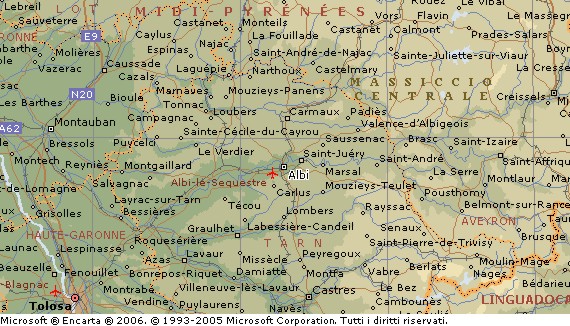
Petrus Gillius o Gyllius:
naturalista francese (Albi, dipartimento di Tam, 1490 - Roma 1555). Ebbe una
predilezione per l’ittiologia e si dedicò all’esplorazione della vita
marina delle coste meridionali della Francia e dell’Adriatico, tanto che
scrisse un libro sui nomi francesi e latini dei pesci che fece parte di un
volume in cui compare anche la traduzione in latino dell’opera di Claudio Eliano![]() La natura degli animali, oltre a delle aggiunte - accessiones - cui
fa riferimento Conrad Gessner.
La natura degli animali, oltre a delle aggiunte - accessiones - cui
fa riferimento Conrad Gessner.
Ecco il titolo completo di quest’opera stampata a
Lione nel 1533: Ex Aeliani historia per Petrum Gyllium latini facti,
itemque ex Porphyrio![]() ,
Heliodoro
,
Heliodoro![]() ,
Oppiano
,
Oppiano![]() ,
tum eodem Gyllio luculentis accessionibus aucti libri XVI. De vi et
natura animalium. Ejusdem
Gyllii Liber unus, De Gallicis et Latinis nominibus piscium.
,
tum eodem Gyllio luculentis accessionibus aucti libri XVI. De vi et
natura animalium. Ejusdem
Gyllii Liber unus, De Gallicis et Latinis nominibus piscium.
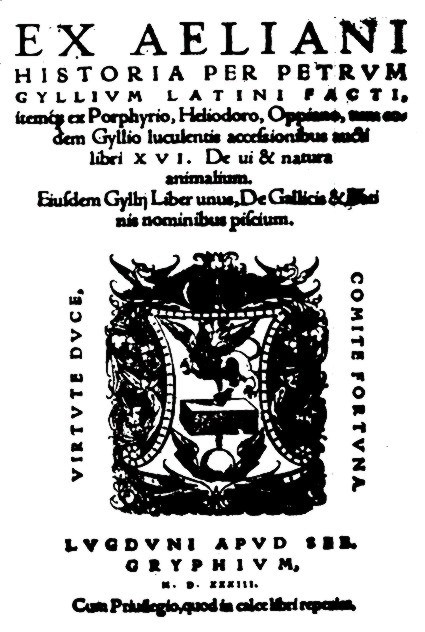
Nel 1544 Gilles lasciò la Francia al seguito di un’ambascieria francese di cui faceva parte il cosmografo reale André Thevet d'Angoulême e sembra che abbia soggiornato a Costantinopoli dal 1544 al 1547, raccogliendo fonti letterarie e indagando i ruderi della città antica, scrivendo poi De Topographia Constantinopoleos et de illius antiquitatibus libri IV e successivamente De Bosphoro Thracio libri III che vennero completati dal nipote Antoine Gilles e stampati a Lione nel 1561.
Pierre
era morto a Roma il 5 gennaio 1555 e venne sepolto nella chiesa di San
Marcello![]() .
.
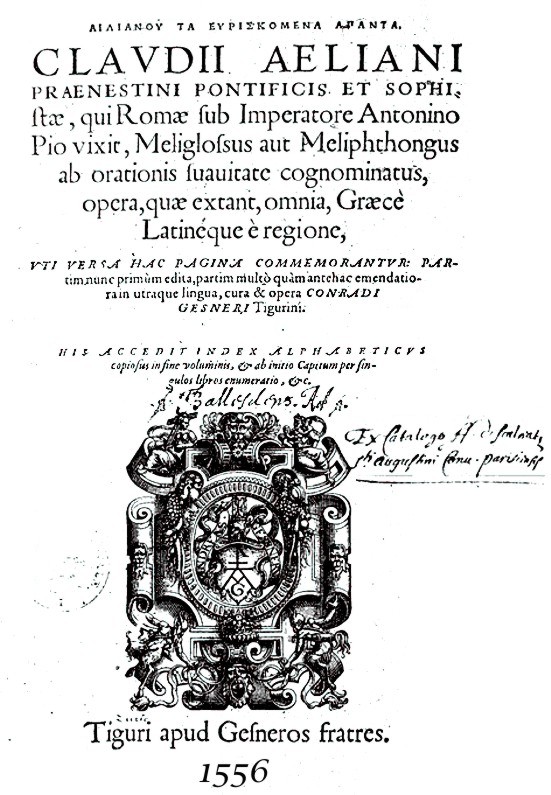
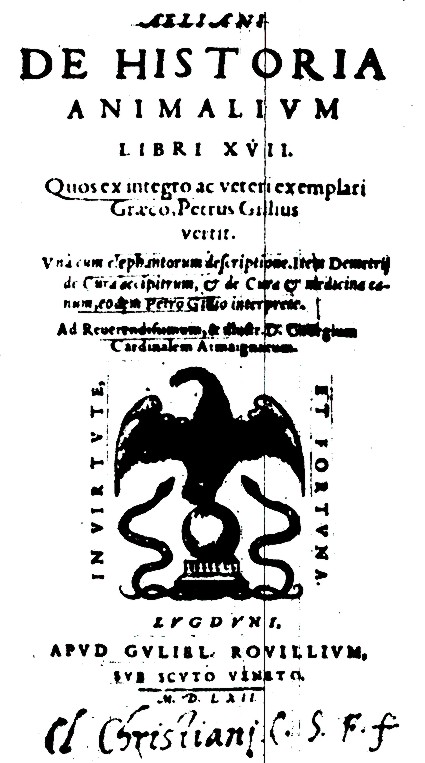
Pierre Gilles, or Petrus Gyllius as he is known from his Latin texts, was born in Albi in 1490. We do not know very much about his youth and early education. Judging from his later work and interests, however, it is clear that he shared the education and enthusiasms of the new generation of French Humanists. This included his contemporaries François Rabelais, Jacques Lefevre D'Etaples, and Guillaume Budé, all Humanist friends or disciples of Erasmus and the Italian Humanists.
Gilles
took an early interest in natural science, especially ichthyology, and studied
the marine life along the southern coast of France and the Adriatic, in 1533
publishing his One Book on the French and Latin Names of the Fish. He
followed the example of the best Humanists by editing the works of his
contemporaries. Among his editions are Elio Antonio de Nebrija's![]() (ca. 1442
– 1532) A
Dictionary of Place Names and Lorenzo Valla's History of King Ferdinand
of Aragon. He also published a Greek-Latin Lexicon, a translation of the
Greek Father Theoderit's Commentary on the twelve minor prophets, and a
selection of texts from Aelian, Porphyry, Heliodorus and Oppian, among others.
(ca. 1442
– 1532) A
Dictionary of Place Names and Lorenzo Valla's History of King Ferdinand
of Aragon. He also published a Greek-Latin Lexicon, a translation of the
Greek Father Theoderit's Commentary on the twelve minor prophets, and a
selection of texts from Aelian, Porphyry, Heliodorus and Oppian, among others.
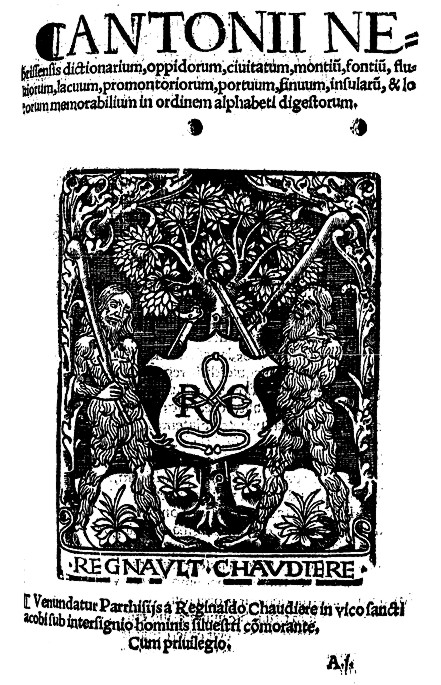
Antonii
Nebrissensis Dictionarium oppidorum, civitatum, montium, fontium, fluviorum,
lacuum,
promontoriorum, portuum, sinuum, insularum et locorum memorabilium,
in ordinem alphabeti digestorum.
Venundatur
Parrhisiis a Reginaldo Chaudiere,
in vico sancti Jacobi, sub intersignio hominis silvestri commorante.
Alexandria
cognomine palearum oppidum liguriae
Forum fulvij oppidum galliae cisalpinae
Alessandria oggi in Piemonte vi compare come Alessandria della paglia in
Liguria
Valenza (AL) è Forum Fulvii nella Gallia Cisalpina
In 1544 Gilles left France with a French embassy that included the king's royal cosmographer, André Thevet d'Angoulême. Gilles seems to have spent the years 1544 to 1547 in Constantinople, gathering literary sources and investigating the physical remains of the ancient city. Out of money, in 1548 he enlisted in Süleiyman's army and joined the expedition against Persia. In 1548 he met the French ambassador to the Sublime Porte, Gabriel d'Aramon, who took Gilles with him to the Holy Land and Egypt.
In
January 1550, still in d'Aramon's company, Gilles returned to Constantinople.
That same year he travelled with the ambassador back to France. Almost
immediately upon his return, however, Gilles headed south to Rome. While in
Rome Gilles began the work of sifting through the large number of source
materials and notes that he had accumulated on the history of Constantinople.
Gilles had made great progress in completing his book on Constantinople by
1555; but then, as the epitaph on his tomb tells us, he was stricken by a
fever that he fought for eleven days before dying at the fourth hour on
January 5, 1555. His patron Georges d'Armagnac provided for his funeral and
his tomb, in the church of San Marcello![]() in Rome.
in Rome.
From his epitaph we learn that Gilles was hard at work organizing his notes for his two works on Constantinople when he died. He apparently left these incomplete, how-ever; and his nephew, Antoine Gilles, then took up the task of finishing his work. This he did faithfully; and in the 1560s a string of books emerged from his stewardship. The most important for our purposes appeared in Lyon in 1561 and were his Three Books on the Thracian Bosporus and the Topography of Constantinople and Its Antiquities in Four Books.
www.italicapress.com
Il nucleo
originario risale al IV secolo, quando il pontefice Marcello I![]() [308-309] fu costretto dall'Imperatore Massenzio a servire messa nel 'Catabulum',
la stazione postale di Roma Antica. Ricostruita nel XII secolo, ceduta nel
1368 all'Ordine dei Servi di Maria, nel 1519 fu distrutta da un incendio. La
ricostruzione iniziò sotto la direzione di Jacopo Sansovino, che venne
sostituito ai lavori nel 1527 da Antonio Sangallo il Giovane. La facciata
concava, di travertino, a due ordini collegati da palme, fu aggiunta da Carlo
Fontana tra il 1682-86. La decorazione tardo-barocca è completata dalle
sculture di Francesco Cavallini e dal rilievo di Ercole Antonio Raggi.
[308-309] fu costretto dall'Imperatore Massenzio a servire messa nel 'Catabulum',
la stazione postale di Roma Antica. Ricostruita nel XII secolo, ceduta nel
1368 all'Ordine dei Servi di Maria, nel 1519 fu distrutta da un incendio. La
ricostruzione iniziò sotto la direzione di Jacopo Sansovino, che venne
sostituito ai lavori nel 1527 da Antonio Sangallo il Giovane. La facciata
concava, di travertino, a due ordini collegati da palme, fu aggiunta da Carlo
Fontana tra il 1682-86. La decorazione tardo-barocca è completata dalle
sculture di Francesco Cavallini e dal rilievo di Ercole Antonio Raggi.
La pianta interna è a una navata, ripartita da lesene di ordine corinzio con cinque cappelle per lato. A sinistra dell'ingresso il monumento del cardinale Giovanni Michiel e di suo nipote Antonio Orso capolavoro del Sansovino. In controffacciata la 'Crocifissione' di Giovan Battista Ricci. [1613] Lungo la navata destra nella prima cappella 'Annunciazione' di Lazzaro Baldi; nella seconda 'Martirio delle Ss. Degna e Merita' di Pietro Barbieri; [1727] nella terza 'Madonna col Bambino' affresco del tardo 1300, episodi della vita della Vergine di Francesco Salviati, affreschi e dipinti di G.B.Ricci; nella quarta cappella sulla volta la 'Creazione di Eva, Marco e Giovanni', affreschi di Perin del Vaga, 'Matteo e Luca' iniziati da Del Vaga e terminati da Daniele da Volterra. All'interno il prezioso ciborio su disegno di Carlo Bizzaccheri; [1691] nella quinta il monumento del cardinale Fabrizio Paolucci di Pietro Bracci [1726] e monumento del cardinale Camillo Paolucci di Tommaso Righi. [1776]
Alle pareti pitture di Aureliano Milani. Sulla navata sinistra nella quinta cappella 'S.Filippo Benizi' di Pier Leone Ghezzi; [1725] nella quarta 'Conversione di San Paolo' di Federico Zuccari [1560] autore assieme al fratello Taddeo nella volta e ai lati delle 'Storie di S.Paolo'. All'interno della cappella i busti di Muzio, Roberto, Lelio Frangipane, realizzati da Alessandro Algardi. [1630-40] Nella terza cappella a sinistra 'Addolorata' di Pietro Paolo Naldini, 'Sacrificio di Isacco e ritrovamento di Mosè' di Domenico Corvi; nella prima 'Madonna e i sette santi fondatori dei Serviti' di Agostino Masucci.
www.romecity.it
Papa,
santo (fine sec. III - inizio sec. IV). Non è menzionato nella storia di
Eusebio![]() ,
e probabilmente venne confuso con il predecessore Marcellino. Avrebbe
governato la Chiesa dal 308 al 309 durante la persecuzione dioclezianea. Il Liber
Pontificalis ricorda la sua organizzazione della Chiesa romana in
venticinque parrocchie. Secondo l'epitaffio di Damaso I, quando impose la
penitenza ai lapsi (apostati) durante la persecuzione, a causa di disordini
pubblici fu esiliato dall'imperatore Massenzio come disturbatore della pace
della città, e morì poco dopo. Festa il 16 gennaio.
,
e probabilmente venne confuso con il predecessore Marcellino. Avrebbe
governato la Chiesa dal 308 al 309 durante la persecuzione dioclezianea. Il Liber
Pontificalis ricorda la sua organizzazione della Chiesa romana in
venticinque parrocchie. Secondo l'epitaffio di Damaso I, quando impose la
penitenza ai lapsi (apostati) durante la persecuzione, a causa di disordini
pubblici fu esiliato dall'imperatore Massenzio come disturbatore della pace
della città, e morì poco dopo. Festa il 16 gennaio.
Pope St. Marcellus I
His date of birth unknown; elected pope in May or June, 308; died in 309. For some time after the death of Marcellinus in 304 the Diocletian persecution continued with unabated severity. After the abdication of Diocletian in 305, and the accession in Rome of Maxentius to the throne of the Caesars in October of the following year, the Christians of the capital again enjoyed comparative peace. Nevertheless, nearly two years passed before a new Bishop of Rome was elected. Then in 308, according to the "Catalogus Liberianus", Pope Marcellus first entered on his office: "Fuit temporibus Maxenti a cons. X et Maximiano usque post consulatum X et septimum" ("Liber Pontif.", ed. Duchesne, I, 6-7). This abbreviated notice is to be read: "A cons. Maximiano Herculio X et Maximiano Galerio VII [308] usque post cons. Maxim. Herc. X et Maxim. Galer. VII [309]" (cf. de Rossi, "Inscriptiones christ. urbis Romæ", I, 30).
At Rome, Marcellus found the Church in the greatest confusion. The meeting-places and some of the burial-places of the faithful had been confiscated, and the ordinary life and activity of the Church was interrupted. Added to this were the dissensions within the Church itself, caused by the large number of weaker members who had fallen away during the long period of active persecution and later, under the leadership of an apostate, violently demanded that they should be readmitted to communion without doing penance.
According to the "Liber Pontificalis" Marcellus divided the territorial administration of the Church into twenty-five districts (tituli), appointing over each a presbyter, who saw to the preparation of the catechumens for baptism and directed the performance of public penances. The presbyter was also made responsible for the burial of the dead and for the celebrations commemorating the deaths of the martyrs. The pope also had a new burial-place, the Cœmeterium Novellœ on the Via Salaria (opposite the Catacomb of St. Priscilla), laid out.
The "Liber Pontificalis" (ed. Duchesne, I, 164) says: "Hic fecit cymiterium Novellae via Salaria et XXV titulos in urbe Roma constituit quasi diœcesis propter baptismum et pœnitentiam multorum qui convertebantur ex paganis et propter sepulturas Inartyrum". At the beginning of the seventh century there were probably twenty-five titular churches in Rome; even granting that, perhaps, the compiler of the "Liber Pontificalis" referred this number to the time of Marcellus, there is still a clear historical tradition in support of his declaration that the ecclesiastical administration in Rome was reorganized by this pope after the great persecution.
The work of the pope was, however, quickly interrupted by the controversies to which the question of the readmittance of the lapsi into the Church gave rise. As to this, we gather some light from the poetic tribute composed by Damasus in memory of his predecessor and placed over his grave (De Rossi, "Inscr. christ. urbis Romæ", II, 62, 103, 138; cf. Idem, "Roma sotterranea", II, 204-5). Damasus relates that the truth-loving leader of the Roman Church was looked upon as a wicked enemy by all the lapsed, because he insisted that they should perform the prescribed penance for their guilt. As a result serious conflicts arose, some of which ended in bloodshed, and every bond of peace was broken. At the head of this band of the unfaithful and rebellious stood an apostate who had denied the Faith even before the outbreak of persecution.
The tyrannical Maxentius had the pope seized and sent into exile. This took place at the end of 308 or the beginning of 309 according to the passages cited above from the "Catalogus Liberianus", which gives the length of the pontificate as no more than one year, six (or seven) months, and twenty days. Marcellus died shortly after leaving Rome, and was venerated as a saint. His feast-day was 16 January, according to the "Depositio episcoporum" of the "Chronography" of 354 and every other Roman authority. Nevertheless, it is not known whether this is the date of his death or that of the burial of his remains, after these had been brought back from the unknown quarter to which he had been exiled. He was buried in the catacomb of St. Priscilla where his grave is mentioned by the itineraries to the graves of the Roman martyrs as existing in the basilica of St. Silvester (De Rossi, "Roma sotterranea", I, 176)
A fifth-century "Passio Marcelli", which is included in the legendary account of the martyrdom of St. Cyriacus (cf. Acta Sanct., Jan., II, 369) and is followed by the "Liber Pontificalis", gives a different account of the end of Marcellus. According to this version, the pope was required by Maxentius, who was enraged at his reorganization of the Church, to lay aside his episcopal dignity and make an offering to the gods. On his refusal, he was condemned to work as a slave at a station on the public highway (catabulum). At the end of nine months he was set free by the clergy; but a matron named Lucina having had her house on the Via Lata consecrated by him as "titulus Marcelli" he was again condemned to the work of attending to the horses brought into the station, in which menial occupation he died. All this is probably legendary, the reference to the restoration of ecclesiastical activity by Marcellus alone having an historical basis. The tradition related in the verses of Damasus seems much more worthy of belief. The feast of St. Marcellus, whose name is to this day borne by the church at Rome mentioned in the above legend, is still celebrated on 16 January. There still remains to be mentioned Mommsen's peculiar view that Marcellus was not really a bishop, but a simple Roman presbyter to whom was committed the ecclesiastical administration during the latter part of the period of vacancy of the papal chair. According to this view, 16 January was really the date of Marcellinus's death, the next occupant of the chair being Eusebius (Neues Archiv, 1896, XXI, 350-3). This hypothesis has, however, found no support.
Catholic Encyclopedia
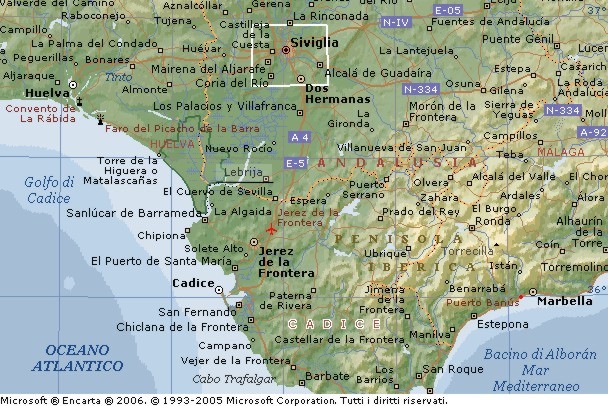
Nome con
cui è noto l'umanista e filologo spagnolo Elio Antonio Martínez de Cala y
Jarava Hinojosa (Lebrija o Nebrija, Andalusia, ca. 1442 - Alcalá de Henares
1532). Compiuti gli studi a Salamanca, trascorse circa nove anni (1461-70) a
Bologna, dove si svolse la sua formazione umanistica, sulle orme soprattutto
di Lorenzo Valla. Tornato in Spagna, insegnò all'Università di Salamanca
(1475-1513), poi in quella di Alcalá de Henares, dove collaborò alla
monumentale Bibbia poliglotta![]() del cardinale Cisneros
del cardinale Cisneros![]() .
.
Profondo
conoscitore, oltre che delle lingue classiche, dell'ebraico, scrisse opere di
teologia (Quinquagenae), diritto (Lexicon iuris civilis),
archeologia (Antigüedades de España), pedagogia (De liberis
educandis libellus), retorica (Artis Rhetoricae compendiosa coaptatio),
storiografia (Rerum gestarum decades duae, traduzione, con pochi
interventi sostanziali, della cronaca di Hernando del Pulgar), filosofia,
cosmografia, botanica; compose poesie nel più classico latino; commentò
autori antichi (Persio, Prudenzio![]() ).
).
Ma i suoi meriti maggiori sono indubbiamente quelli di filologo e grammatico. Le sue lezioni universitarie, Introductiones latinae (1481), da lui stesso tradotte poi in volgare e ristampate innumerevoli volte nel corso dei sec. XV e XVI, riportarono a un latino più aderente al modello classico, insegnato secondo i metodi dell'umanesimo. I suoi dizionari latino-spagnolo (1492) e spagnolo-latino (1495) rappresentano il punto di partenza di tutta la lessicografia spagnola; la sua Gramática en lengua castellana (1492), da lui più tardi (1517) integrata con le Reglas de ortografia castellana, è la prima che si conosca di una lingua neolatina e costituì la base delle conoscenze grammaticali del siglo de oro.